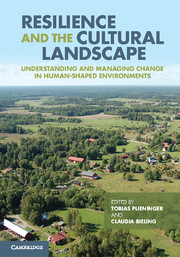 Resilience and the Cultural Landscape
Resilience and the Cultural Landscape Published online by Cambridge University Press: 05 November 2012
Introduction
Although the term landscape has acquired various meanings between cultures and over the centuries (Wylie, 2007), its perceived qualities have consistently related to landform, aesthetics, history, regional identity, rules and customs. It has thus been understood as a territory, whose essence can often be apprehended in a single gaze, and possessing a distinct visual and cultural signature. Latterly, the idea of landscape has become more encompassing, as it has extended beyond the realms of aesthetics, physical geography and human geography to include ecological processes and human well-being. In this perspective, it is a physical and conceptual nexus in which many human and natural systems find their integration – it is an indivisible whole possessing intimately connected form, function and meaning.
While both natural and social scientists have long acknowledged the dynamics of cultural landscapes, public policies have tended to adopt a more static approach, either seeking to designate areas of fine scenery or to mitigate the visual impact of development. Contemporary landscape policy, however, more actively embraces ‘drivers of change’ (Schneeberger et al., 2007; Winn et al., 2011), by both promoting sustainable management of landscape per se, and influencing the practices of other landscape-producing activities such as forestry, agriculture and construction (Figure 2.1). While all landscapes are dynamic, however, their nature and pace of change differ greatly and thus they require tailored strategies reflecting a deeper understanding of where they have come from and where they are going to. For example, the European Landscape Convention (ELC) (Council of Europe, 2000) promotes strategies with different balances between ‘planning, management and protection’.
To save this book to your Kindle, first ensure [email protected] is added to your Approved Personal Document E-mail List under your Personal Document Settings on the Manage Your Content and Devices page of your Amazon account. Then enter the ‘name’ part of your Kindle email address below. Find out more about saving to your Kindle.
Note you can select to save to either the @free.kindle.com or @kindle.com variations. ‘@free.kindle.com’ emails are free but can only be saved to your device when it is connected to wi-fi. ‘@kindle.com’ emails can be delivered even when you are not connected to wi-fi, but note that service fees apply.
Find out more about the Kindle Personal Document Service.
To save content items to your account, please confirm that you agree to abide by our usage policies. If this is the first time you use this feature, you will be asked to authorise Cambridge Core to connect with your account. Find out more about saving content to Dropbox.
To save content items to your account, please confirm that you agree to abide by our usage policies. If this is the first time you use this feature, you will be asked to authorise Cambridge Core to connect with your account. Find out more about saving content to Google Drive.